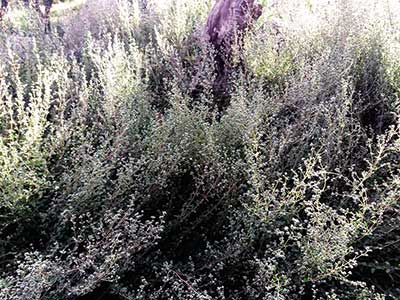«The production of herbs is in harmony with nature and gives a cultural product, «the farmer Vangelis Geronimakis stressed in an interview with Nektarios Sfakion.
Q. What herbs are grown?
A. The herbs we cultivate are: dittana, oregano, lavender, marjoram, peppermint, sage, safflower, aloe vera, alfalfa, mint, myrtle, laurel, dwarf, small quantities of thyme etc.
Q. What do the herbs produced give to the human body?
A. Herbs are used in many ways, such as cooking as flavor and olfactory enhancers. For beverages, where each has its own properties, also combinations of herbs, such as the mallow with the marjoram, can also be made. And the third category is that they are used as essential oils. Essential oils are used in cosmetology (human body care), climatotherapy, paramedics (they do not substitute for medical treatment and the doctor has the first opinion)
Q. What do they offer to the human body?
A. Dittama is an endemic plant found on Crete and used as a beverage. Hippocrates used it against stomach and digestive disorders, rheumatism, arthritis, healing, menopause, tonic and antispasmodic.
Marjoram in Greece has been known since ancient times to use it as a medicine against stomach and intestinal discomfort.
The oregano has many pharmaceutical properties, with the main (known pharmaceutical) active substance carbaprol.
In particular, they are anti-diarrheal, anti-inflammatory, bactericidal. In the form of beverages is used for bowel weakness, expectorant for cough, helps in hypertension and atherosclerosis.
Sage is used in beverage therapy in-house as antiperspirant (especially against night sweats of tuberculous and neuralgia). Sage in the form of a beverage is ideal for oral therapies in case of injuries, bruises, pharyngitis and gingivitis.
Thyme in a beverage can be used to treat cough and bronchitis. To prepare an infusion, put 1 tablespoon dry or 2 tablespoons of fresh herb, without stalk, into 1 cup of boiling water, cover it for 10 minutes and then strain it.
St. John’s wort grows in many regions and is highly regarded as a healing herb. It is a small plant that reaches a height of 80 cm. Its leaves are many, small, oval, pale green and have dark spots on the edges.
Contains tannin, flavonoids, red dye (hypericin), resin, volatile oils, glycosides and others.
At the time of the Drydes, the safflower was considered as a blessed plant, which only suffered its aroma to expel the demonic spirits.
Dioscuriides, a famous herbalist in ancient Greece, claims that local herbal use helps heal burns, and its consumption in the form of a beverage relieves indigestion and colic pain, but should be given until full healing.
Aloe is a naturally occurring plant growing in warm regions of the planet, while in Greece it is abundant. It is related to onion, garlic, asparagus and turnip and this affinity appears during its flowering.
Aloe contains amino acids (the eight basic and other non-essential), anthraquinones (12 anthraquinones are found in its cortex and have antibiotic, bactericidal, antiviral, antiinflammatory and analgesic properties), enzymes (amylase, catalase, alkaline phosphatase, , minerals (calcium, copper, iron, magnesium, potassium, phosphorus, sodium, zinc), sugars (monosaccharides and polysaccharides), malic acid, salicylic acid, saponins, steroidal fatty acids, lectins and vitamins (A, B, B2, B3, B6, B12, C, E).
Myrtle is a kind of plant belonging to the myrtus genus (Myrtus) and the Myrtaceae family. The genus of myrrh includes about 75 species, which thrive in tropical and subtropical regions. In Greece, Myrtus communis, native or decorative, is found. It is grown in the open air, in pots and in greenhouses. It is used in perfumery, cosmetics and pharmaceuticals. It produces essential oil (butter oil). Its durable wood is used in softwood and its branches in basketry. The plant has been known since ancient times, and Dioskouridis mentions it.
Diocourides classified the myrtles into blue and white-fruit, which have medicinal properties. It gave them an antidote for scorpion and spider stings and to cure bladder diseases and diarrhea in the form of boiled juice.
Q. How many years have herbs been produced?
A. About the last 20 years I have been growing herbs. My visitors observe the production process. The production of herbs is in harmony with nature and gives a cultural product.
Herbs and cultural products

